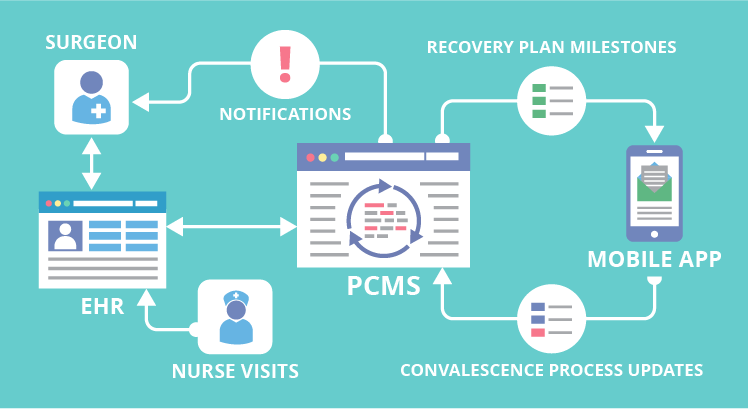Post-surgery mHealth application: escaping the twilight zone
Andrei Khomushka introduces the concept of a postoperative mHealth app designed to keep patients connected to their care teams during recovery. He outlines the app's architecture, usage scenario, and benefits, demonstrating how mHealth app development can enhance patient monitoring, prevent complications, and reduce readmissions.
During the process of postoperative recovery, patients might disregard or mistreat symptoms, thus triggering complications. As the research on the impact of surgical-site infections in the 1990s (by Kirkland K.B. et al.) shows, patients experiencing surgical-site infections have a 15 times greater risk of readmission within 30 days after discharge. In this case, the patient’s stay in hospital increases by an average of 6.5 days and the treatment cost – by more than $3,000.

Sadly, when patients are discharged, they enter the twilight zone where caregivers can’t track the individuals’ health status between nurse visits and thus ensure successful convalescence. Or… can they?
We came up with a concept of a postoperative mHealth application integrated with the EHR and designed to continually monitor patients’ recovery progress. It helps patients to avoid the twilight zone and stay connected to their caregivers during the whole post-surgery period.
Architecture
The core element of our concept is an HIPAA-compliant Postoperative Care Management System (PCMS) connected to both the EHR and the mobile application (as its backend). The PCMS’s main functions include:
- Empowering inbound and outbound data flow to and from the mobile app
- Notifying surgeons about significant patient events, such as fever, dehiscence and more
- Exchanging health data information with the EHR
The PCMS analyzes updates from the patient, uploads the data into the EHR, and, if needed, notifies surgeons about the important changes in the patient’s condition. Moreover, the postoperative care management system sends personalized messages to patients and processes their current health status data, completing the loop.

Surgeon to patient: recovery plan milestones
The PCMS provides patients with EHR-personalized information essential for smooth convalescence, such as:
- Medication intake scheme (according to the recovery plan)
- Instructions (on surgical wound and drain care, self-check, exercising, etc.)
- Recommendations on nutrition and hydration (increase protein consumption, reduce sugar and salt, take probiotics, etc.)
- Reminders to change dressings, take an incision photo, send daily health status updates, etc.
Patient to surgeon: convalescence process updates
To allow surgeons, nurses and other care team specialists timely react to their health status changes, the person should provide caregivers with the following data:
- Subjective (fever, pain, dizziness, nausea, etc.)
- Objective (temperature, pus, bruises, swelling, seroma, dehiscence, etc.)
- Medication intake
- Incision photos
The patient just records their vitals and sensations into the corresponding fields in the app and taps ‘Send’.
Possible usage scenario
A surgeon creates a postoperative recovery plan in the EHR or the PCMS according to the particular patient’s surgery type (cardiac, gastrointestinal, orthopedic, general, breast surgery, etc.), allergies, life style, dietary habits, physical activity level and more.
The patient receives their individual recovery plan via the mobile app and follows the recommendations and instructions (as described above). They also input and send to caregiver information such as temperature, general well-being, incision photos taken during the surgical wound care routine, discomfort and more.
Based on the provided and processed data, the postoperative care management system tracks the patient’s current condition, and notifies the surgeon or the patient (via the post-surgery app), if needed.
For example, the PCMS matches the sets of subjective and objective symptoms provided by the patient and determines the high probability of an SSI (surgical site infection) development. In this case, the app warns a surgeon about the potential complications (e.g. an organ or space SSI) and suggests scheduling an appointment to discuss changes in medication, surgical wound/drain care gaps and other elements that may impede the recovery process. All these interactions are powered by the PCMS-based notifications.
Benefits of escaping the twilight zone
Patients and caregivers can equally benefit from the advanced healthcare software development approach, where post-surgery mobile apps are tightly bound to patients’ daily incision management and recovery processes. An EHR-connected postoperative application can ensure the following bonuses:
- Improved health outcomes – reducing the risk of complications (up to hemorrhage, acute kidney injury, bowel obstruction, malignancy, etc.)
- Reduced readmissions through uninterrupted and constant communication with patients
- Reduced nurse visits and patient appointments, as patients learn to control their recovery process at home
If you want to find out more about the post-surgery app as well as about the PCMS concept and its integration with an EHR, feel free to contact us. We’ll be happy to discuss the details and offer you a free consultation and a PoC.

